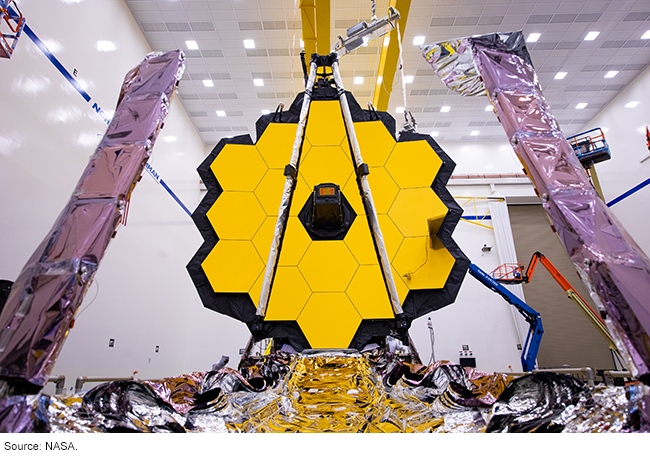NASA: Lessons from Ongoing Major Projects Can Inform Management of Future Space Telescopes
Fast Facts
A recent National Academies report proposed new space telescopes for NASA, potentially adding to NASA's 3 current major space telescope projects. One current project (the James Webb Space Telescope) plans to launch in December after years of delays and cost increases.
We testified that NASA's success with future space telescope projects will depend on its ability to:
- Better manage its large projects, which have ripple effects on its whole portfolio
- Minimize risk in decision making and assess risk realistically
- Consistently update cost and schedule information for decision makers, like Congress

Highlights
What GAO Found
The National Aeronautics and Space Administration (NASA) relies on complex instruments and spacecraft to accomplish its missions—including to better understand the universe and our place in it. NASA's astrophysics projects currently include three major space telescopes (see figure).
James Webb Space Telescope (JWST) continues to make progress toward its planned launch in December 2021, 90 months later than originally planned.
Nancy Grace Roman Space Telescope (Roman) set cost and schedule baselines in February 2020, but COVID-19 led to cost and schedule growth.
Spectro-Photometer for the History of the Universe, Epoch of Re-ionization and Ices Explorer (SPHEREx) set cost and schedule baselines in January 2021. Technical problems pushed the critical design review to January 2022.
National Aeronautics and Space Administration's (NASA) Major Space Telescope Projects

Three lessons learned from GAO's work, some of which NASA has adopted, provide NASA an opportunity to strengthen management of future space telescopes.
Manage cost and schedule performance for large projects to limit portfolio implications for portfolio. Increases associated with NASA's most costly and complex missions have cascading effects on the rest of the portfolio, and JWST's cost and schedule increases over the years have had outsized effects.
Minimize risk in program decisions to better position projects for successful execution. GAO has found that major projects often underestimate cost and technical risk, contributing to cost overruns and unstable designs.
Consistently update cost and schedule estimates to provide realistic information to decision makers. NASA now requires major projects to develop and update a joint cost and schedule confidence level—an integrated analysis of a project's cost, schedule, risk, and uncertainty.
Why GAO Did This Study
The projects in NASA's current portfolio of major space telescopes—JWST, Roman, and SPHEREx—have roots in past decadal surveys on Astronomy and Astrophysics from the National Academies of Sciences, Engineering, and Medicine. NASA is now considering the results of the National Academies' 2020 decadal survey, which may spur new projects in this portfolio.
NASA has made improvements in acquisition management in recent years, but it remains a long-standing challenge for the agency.
This statement reflects GAO's observations on (1) the current status of NASA's major telescope projects, and (2) lessons learned that can be applied to NASA's management of its future telescope projects as it considers the results of this decadal study. This statement is based on ongoing work on the status of NASA's major projects, which is planned to be published in Spring spring 2022, and past GAO reports on JWST and NASA's acquisitions of major projects.
Recommendations
In prior work, GAO has made recommendations to improve NASA's acquisition of major projects. NASA generally agreed with most of those recommendations and implemented changes in response.
As of November 2021, NASA has not fully addressed eight open priority recommendations related to monitoring program costs and execution. Those recommendations were detailed most recently in a report to the NASA Administrator in June 2021.
